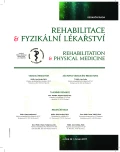-
Medical journals
- Career
Extra Health Programme-Outcome after Five Years
Authors: M. Betlachová; P. Uhlíř
Authors‘ workplace: Katedra fyzioterapie FTK UP, Olomouc
Published in: Rehabil. fyz. Lék., 24, 2017, No. 2, pp. 123-126.
Overview
The aim of the high standard rehabilitation programme was to verify and also to find out to what extent it is possible to influence chronic pain of observed patients and to monitor the specific factors that contribute to the chronic pain relief. 233 patients with chronic pain lasting more than three months (despite intensive therapy) went through the one office of our rehabilitation facility (R.R.R. Center - Center for the treatment of pain and movement disorders in Olomouc). 89 patients refused to participate in the rehabilitation programme. Three patients who agreed to participate in this programme had resigned after the apology during the treatment, rest of the patients resigned without apology. In cooperation with general practitioners and specialists the diagnostic and treatment efforts were focused maximally on 42 remaining patients. Complete regression of the chronic pain was recorded in cases of all of the 42 patients (16 men and 26 women). The treatment clarified that in etiological summary also functional musculoskeletal disorders participated besides the organic causes of chronic pain. These functional musculoskeletal disorders were the main etiological cause of the chronic pain. Promptly after removal of these disorders there came a pain relief up to 0 on a Visual Analogue Scale. The essential finding is that the organic changes proven on input with expectancy of long lasting course of chronic pain are not the main etiological cause of the chronic pain. On the contrary the main cause are the functional musculoskeletal disturbances with expectancy of effective treatment and possibility of complete regression of the chronic pain. Pathological reflex changes (Trigger and Tender points) participated dominantly in the pain symptomatics.
Keywords:
health program, chronic pain therapy, patient
Sources
1. BECK, A. T., STEER, R. A., BROWN, G. K.: Manual for the Beck Depression Inventory-II. 1996. In Preiss, M.; Vacíř, K. (Eds.) Beckova sebeposuzovací škála depresivity pro dospělé: BDI–II, Brno, Psychodiagnostika, 1999, s. 22.
2. BOGDUK, N., McGUIRC, B.: Medical management of acute and chronic low back pain. Pain research and Clinical Management. Elsevier, 2002, s. 115-204.
3. KOLAŘÍK, J.: Vertebrogenní algický syndrom. Postgraduální medicína, 3, s. 285-296.
4. KNOTEK, P.: Dotazník copingu bolesti. Restandardizace. Bolest, 2005, 2, s. 90-94.
5. OPAVSKÝ, J.: Vyšetřování osob s algickými syndromy a klinické experimentální metody hodnocení bolesti. In R. Rokyta, M. Kršiak, J. Kozák, Bolest: Monografie algeziologie, Praha, Tigris, s. 176-184.
6. SHARPLEY, CH. F., TANTI, A., STONE, J. M., LOTHIAN, P. J.: The effects of life events inventory. Counselling Psychology Quarterly, 2010, 1, s. 45-52.
7. SCHOFFERMAN, J.: Failed back surgery: etiology and diagnostics evaluation. The Spine Journal, 2003, 3, s. 400-403.
8. ŠTĚTKÁŘOVÁ, I.: Bolesti zad. Ambulatná terapia, 5, s. 40-43.
9. TULDER, M.: Low back pain: summary of systematic reviews and clinical guidelines pain 2002-an updated review refresher course syllabus, 2002, s. 267-270.
10. VONDRÁČKOVÁ, D., NERADILEK, F.: Chronická bolest s výjimkou onkologické, ČSL JEP – Doporučené postupy pro praktické lékaře, 2002, s. 2-7.
Labels
Physiotherapist, university degree Rehabilitation Sports medicine
Article was published inRehabilitation & Physical Medicine

2017 Issue 2-
All articles in this issue
- Comparison of Selected Methods for Strengthening Stabilization Muscles of Lumbar Spine in Vertebrogenic Patients
- Influencing Brain Vascular event by Proprioceptive Neuromuscular Facilitation on Stroke Disease
- Evaluation of Postural Stability in Aqua-Belles
- First Experience with Virtual Reality in the Therapy of Spinal Cord Lesions
- Extra Health Programme-Outcome after Five Years
- Carpal Instability
- Analgesic Effect of Hyperbaric Oxygen Therapy
- Rehabilitation & Physical Medicine
- Journal archive
- Current issue
- Online only
- About the journal
Most read in this issue- Carpal Instability
- Influencing Brain Vascular event by Proprioceptive Neuromuscular Facilitation on Stroke Disease
- Comparison of Selected Methods for Strengthening Stabilization Muscles of Lumbar Spine in Vertebrogenic Patients
- Analgesic Effect of Hyperbaric Oxygen Therapy
Login#ADS_BOTTOM_SCRIPTS#Forgotten passwordEnter the email address that you registered with. We will send you instructions on how to set a new password.
- Career

